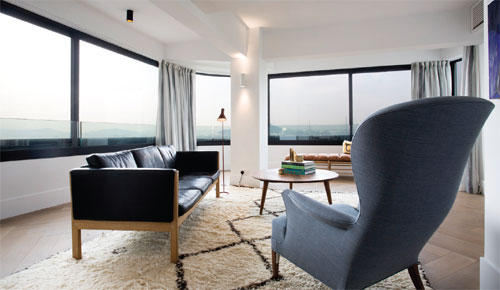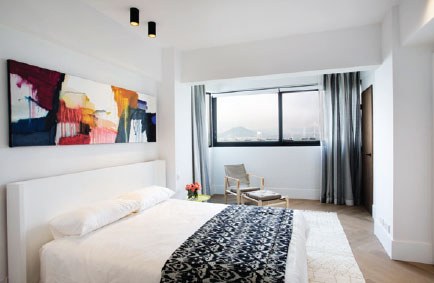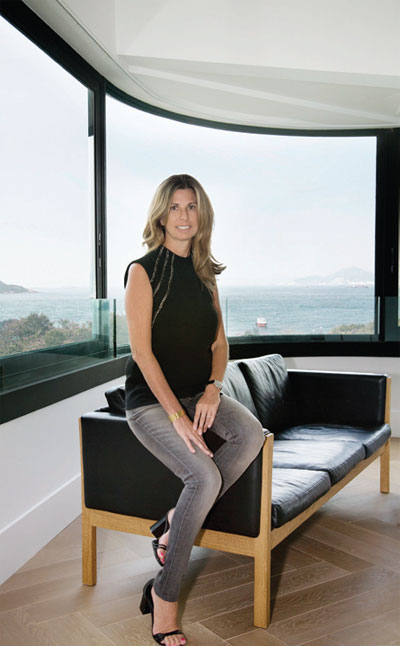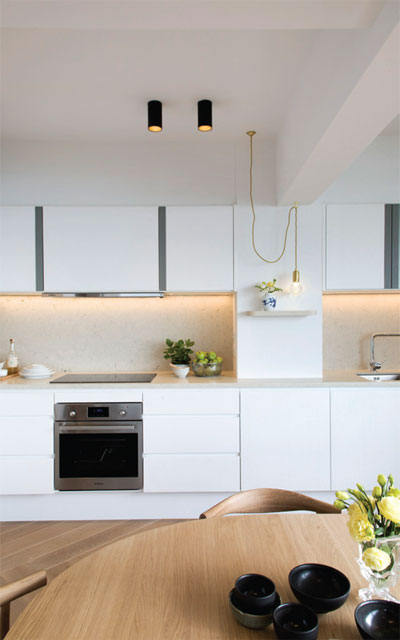Old-style romance
Updated: 2015-03-06 07:30
By Agnes Lu(HK Edition)
|
|||||||
A farsighted developer took a gamble on an aging but iconic tenement building in the Western District and came up with a winner. Agnes Lu reports.
When Victoria Allan initiated her "bold" idea of redeveloping a tong lau, a tenement building built in early 20th century, in Hong Kong's Western District nine years ago, the Australian entrepreneur had no idea the project would take nearly a decade of labor.
The natural curve at the interface of the outer wall of Tung Fat Building had caught Allan's eye immediately when she spotted in back in 2005.
What's more, the tong lau - as walk-up tenement buildings are called in Hong Kong - had a perfect waterfront position in Kennedy Town, offering expansive views of the harbor, with the highrises of Kowloon stretched across the horizon. Central was just a 15-minute drive away, as back then no one had any idea the MTR was headed that way.
"Back in 2005 I was running my residential real estate business, and I could see something was missing in the market - something more interesting, like the conversion of old buildings, or something you only see in New York and London," said Allan, founder of Habitat Property, a Hong Kong-based company specializing in commercial sales and leasing.
Dreams to reality
Nine years on, the finished product mostly matched her initial imagination. The New Praya walk-up, an original nine-story 1960s building, now stands transformed and houses eight stunning New York loft-style apartments with panoramic harbor views, while an elevator - inserted as part of the revamp - saves the trouble of walking up, a rare feature for a tong lau.
Apartments range in size from 960 to 1,320 square feet, including a penthouse with a private rooftop, and monthly rental is offered at HK$48,000 to HK$110,000. Each apartment has two bedrooms, except the first-floor unit, which has just one. The yield is also good - 15 percent based on the cost of purchase and renovation compared to rental levels. That is four times more than the usual market average of 3 percent for mass market units.
The considerable profit reflects the painstaking effort that went into every step of the nine-year project to convert Tung Fat Building into a modern-style residence while preserving its original charm.
The first challenge Allan encountered, as this was her first residential development project, was negotiating with existing tenants in order to acquire total ownership.
With the assistance of an interpreter, the first-time developer managed to talk to every tenant and landlord she could locate and negotiated acquisition and relocation terms.
Some families, especially those with elderly members, were happy to move someplace with an elevator. But for tenants who had not paid rent for a long time and whose respective landlords could not be located either, the team could only resort to the courts for help.
Of all the lengthy negotiations, acquisition talks for the ground floor required the most patience, running for a long five years. The floor had a mechanics' shop and the operator was unwilling to sell, while other family members were the owners of the space.
Eventually a solution was agreed upon - to find the operator another location with similar facilities and neighborhood. "I think you have to understand what people want. Make sure you address their concerns," said Allan.
Five years passed before renovation work could finally start.
Every major modification for the old tong lau had to go through the Buildings Department, which also regarded it as a seldom-spotted creative project and managed to put the innovative conversion under the planning code current at the time. Because "no one wanted to put elevators into old buildings back then," Allan said and laughed.
The first step was repairs and upgrading building services, as in tackling leakage issues, problematic drainage and sewage systems, unsteady ceilings and missing windows.
At least 15 submissions were handed to the Buildings Department, and every few days department officials would arrive to check if the submission was within regulation.
The biggest headache, Allan recalled, was when they found out the interiors in no way matched the building plan they had acquired. "Maybe 50 years ago somebody dug out the sewage pipes and the drainage pipes and changed them, but didn't tell the Buildings Department," Allan said.
So the team had to put everything back to fit the original building plan before submitting an upgrade application with the Buildings Department, a process that was "costly and time-consuming".
The second phase came when an elevator was to be installed. The team tried different locations to facilitate the ride, such as somewhere close to the living rooms, but could only put it next to the fire escape to meet the fire safety codes.
Even the size of the elevator was adjusted to leave room for the fire escape. The shaft space could not be dug below the building so the elevator lobby was instead put at the top of a short flight of stairs.
Preserved charms
The third phase came when architects from Australian design firm Kerry Phelan Design Office (KPDO) handled the interiors with the aim of preserving the old building to the best of their ability. Natural materials and a neutral color palette were chosen in line with the building's original understated charm.
For example, the bathroom and kitchen islands had a special kind of smoky gray marble installed to create synergy between the two areas. The design team toured multiple mainland shops before finally picking this material.
The apartments were also given oak flooring, doors and cabinetry, with custom-made luxury accents such as curved brass handles that hint at traditional Chinese design.
The highlight of the apartments is sliding windows on three sides that dominate the living room, offering panoramic sea views and balmy sea breezes.
The original sweeping, curved glass windows were therefore preserved, while the designers lowered the parapets to maximize views of the horizon.
The team also refurbished the faade of the building, while retaining its original black terrazzo nameplate, emblazoned above the entrance in Chinese script. Inside the building, the staircase handrails in yellow terrazzo were also restored to their former glory.
"Along this part of the Kennedy Town waterfront, the building used to be iconic and was part of the fabric of the area. Its unique features are things I really wanted to keep," said Allan.
Game for more
The ground-floor mechanic's workshop now houses a Mexican-style fusion restaurant. Eight apartments, one on each floor, were all rented out within less than three months since being launched last December. Only rentals are offered currently.
Around HK$60 million in total, divided nearly equally between purchase and renovation costs, was spent on converting the building.
It took nine long years for the project to officially hit the market, well over Allan's initial estimate of three to five years. However, she observed the lack of such specially designed buildings nine years ago, and still thinks the same way.
"Bringing more unique products and more quirky conversions to the market is what a small developer would do to differentiate themselves. There was a gap for such kind of ideas and I still see it today," she said.
But such opportunities are dwindling, and it requires a keen nose to be able to sniff out redevelopment potential. Allan mentioned Chai Wan, North Point and Tin Hau as possible destinations for similar conversion projects, where old buildings, colorful neighborhoods and fine Western-style eateries cozily co-exist.
"I think certain kinds of plot ratio bonus or taxation benefits can be implemented for more developers to revitalize old buildings," said Allan. "But (they should restore) them properly, including finding the right interior design, instead of just keeping the faade."
Although the time spent on acquiring the building and renovating it was much longer than expected, Allan will not hesitate to plunge right in if a similar project presents itself. She said: "If I find somewhere with the same charm I'll do it again."
Contact the writer at agnes@chinadailyhk.com





|
Victoria Allan, founder of Habitat Property, rejuvenated the iconic Tung Fat Building but kept its original black terrazzo nameplate and gave it a New York loft-style makeover, with larger windows offering panoramic sea views, and color and material synergy creating a sense of tranquil harmony in the eight apartments across as many stories. Provided to China Daily |
(HK Edition 03/06/2015 page9)
